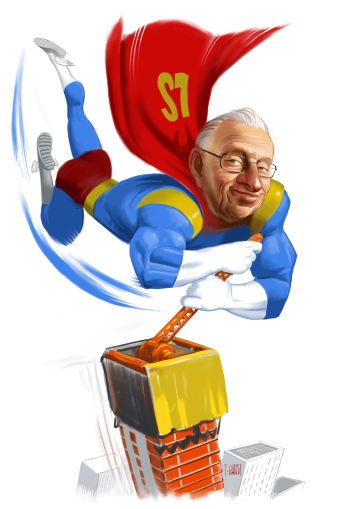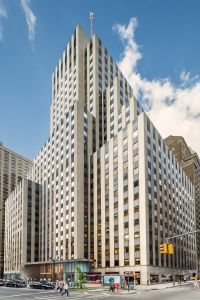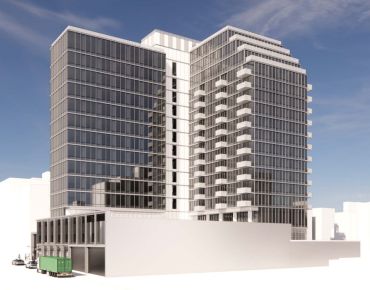When a Project Stalls, Here’s Who Swoops in to Save the Day [Updated]
A number of huge projects around the nation have been stalled but — It’s a bird! It’s a plane! It’s … a mortgage lender!
By Mack Burke September 4, 2019 11:35 am
reprints
Never fear! Your friendly neighborhood lender is here!
When global real estate owner Bizzi & Partners Development broke ground on its supertall 273-unit condominium project downtown at 125 Greenwich Street in 2017, it couldn’t have predicted the super roadblocks ahead. But, the issues started at the time of acquisition, sources said.
In 2014, the development group, led by Bizzi and including Howard Lorber’s New Valley Real Estate, paid The Witkoff Group and Fisher Brothers $185 million for the plot, nearly double what it had traded for just over a year prior.
By the fall of 2017, the developers had begun construction, and they launched condo sales, which ultimately proved lackluster, according to sources that requested anonymity. The units were priced in the “mid-$2,000s to $3,000s per square foot” in a downtown market where “everything’s going for around $2,000,” the source said.
A year later, in the fall of 2018, it was reported that the owners nabbed a hefty $473 million construction package from a bevy of Asian contributors, including Bank of China (BACHF), United Overseas Bank (UOB) and China Cindat, to finish the build out.
Several months later, in March 2019, the project stalled due to a lack of funding after topping out at over 900 feet that month. When the project didn’t meet a desired “proof of concept” sales hurdle as a loan covenant established by its senior lender, Bank of China, the bank declined to fund into the project, a source explained. As of the end of August, the interiors aren’t finished, and sources said “it’s not even watertight” and only around “65 percent complete.”
As it sits dormant, the unpaid debt is rapidly accruing interest and, “when you own a [condo] building that height, if you keep tacking on weeks, it’s a lot of money,” one source said, estimating that the sponsors are incurring costs of at least $2 million per month.
Inquiries to Bizzi & Partners Development and Vector Group, the parent company of Lorber’s New Valley Real Estate, were not returned.
Ground-up construction at this point in the cycle comes with its fair share of risk but stepping in mid-construction or on a distressed project takes a specific kind of lender.
A few months ago, Silverstein Capital Partners, the shiny new lending arm of Larry Silverstein’s Silverstein Properties, as a premier developer with the monetary backing to be the hero, offered to lead the roughly $530 million recapitalization and rescue of the troubled Financial District project.
To date, SCP’s two most high-profile loans were made mid-construction or on new construction. In April, JDS Development Group closed on a $664 million construction package with SCP and Canadian lender Otéra Capital — in which SCP provided a $235 million mezzanine loan — to finally get the ball rolling on its planned tower at 9 DeKalb Avenue in Brooklyn, which will eventually become the borough’s tallest tower.
SCP’s connection to the process of large-scale development makes these types of opportunities especially attractive. And debt funds and other alternative lenders with higher yield targets, or other large “landlord lenders” equipped with eager investment dollars, are ready to swoop in and save the day.
“I think there’s a ton of capital sitting on the sidelines waiting to find distressed opportunities,” said Pacific Western Bank managing director Patrick Crandall. “It won’t be commercial banks, with the regulatory requirements … distressed projects don’t play well with regulators. Some commercial banks may provide some leverage in certain situations, depending on the nature of the distress.”
What caused the problems at 125 Greenwich, though, could’ve been predicted, as one source explained.
The 88-story project topped out in March, followed by Bank of China cutting off funding due to “construction hurdles” and unmet sales projections.
Fellow senior lender and B-note holder UOB had fully funded its portion of the stack when Bank of China decided to turn off the spigot, a source said. By June, the project faced foreclosure action from UOB as well as its mezzanine lender — EB-5 provider United States Immigration Fund (USIF), which contributed a $194 million loan in 2015, one source said. The firms moved to foreclose on a combined $400 million in unpaid debt to essentially force action by the borrowers, the source said.
UOB stopped short of trying to negotiate and salvage its position, instead just moving to sell it off and eject from the project, one source said. Just a couple weeks ago, UOB offloaded its debt position to “a group out of Florida,” one source explained, although they declined to name the buyer.
“[The sponsors have] already built it, but the problem is [that] they’ve spent hundreds of millions more than anyone possibly would ever [buy it for],” said a source with knowledge of the project.
Subsequent Uniform Commercial Code (UCC) auctions planned for early August were snuffed out with the inclusion of Silverstein.
It’s likely that a second financier, possibly an institutional lender, is in line to enter the fray and support Silverstein’s efforts to “clean up the stack,” which will involve bringing in “new players with new cash to balance it out and create a situation where the current subordinate players are not in a position to put the deal back into default,” a source explained.
SCP has put forth a proposal that aims to simply move the ball, sources said. The biggest hurdle has been progress. Along with the infusion of fresh cash, SCP wants to price and offload the units at what the landlord lender feels is at a fair market rate, include enough capital to pay interest and see the project through completion as well as implement a new marketing strategy.
The project was plagued by what a source deemed an “entirely dysfunctional” capital stack, the “poster child” of messiness.
Behind the two senior lenders there are two lenders in subordinate positions: USIF and China Cindat; and behind the two subordinate lenders are four equity holders, one being China Cindat in a preferred equity role and the other three being Bizzi, the Carlton Group and New Valley Real Estate, a source explained.
One source said that Cindat is trying to figure out whether or not it wants to protect its debt position, its equity position, or both. USIF is currently shopping its mezzanine position after triggering the warning-shot UCC foreclosure.
USIF lacks capital, a source said, making it not the ideal entity to assume control of the project’s completion.
“These deals … they take a lot of time and energy,” SCP President Michael May said, speaking generally about getting involved in deals mid-construction. “There are certainly good opportunities [out there]. But, there are days I wake up and I think, ‘Is this the best use [of my time] compared to a down-the-middle deal?’”
May declined to speak about the intricacies of the capital stack or the ongoing negotiations at 125 Greenwich. He did indicate that it should take four or five months to hash out the deal and get the project back up and running.
125 Greenwich is an example of a condo project directly and adversely affected by pricing and ever-shifting market dynamics, as Manhattan’s high-end condo sales market has languished over the last 12 to 18 months.
Regardless, where’s there’s a project in distress, there’s almost always a “hero” lender ready to save the day.
While the cycle has lengthened even further, and the expansion has matured, lending into commercial real estate, overall, has hit record highs in two of the last five years, according to data from the Mortgage Bankers Association. But traditional opportunities are becoming scarcer. Lenders remain hungry, but overall development has dialed back. Growth in new construction dipped to 3 percent last year, from a rate of 11 to 14 percent from 2012 to 2015, according to Dodge Data and Analytics. That rate is expected to remain unchanged in 2019.
A number of economic and fundamental factors have contributed to uncertainty, such as rises in short- and long-term interest rates and cost increases for foreign building materials like steel and aluminum, mostly caused by President Trump’s tariffs.
In July 2018, after the Trump administration implemented a 25 percent tariff on steel imports, the price for flat-rolled steel used to build many high-rise projects in New York climbed to a peak of $920 per ton, the highest mark in a decade.
But, at this stage, and as the trade war trudges on, construction costs alone are in no way the sole detriment to a project.
“If there’s going to be a miss, it’s probably not going to be because of rising construction input costs,” said Savills Chief Economist Heidi Learner, indicating that troubles would more than likely originate from overly-optimistic projections of sales or rental income growth that failed to materialize. Many New York contractors have already begun to price up materials, adding between 5 and 10 percent on total costs, in anticipation of further impacts from tariffs, according to a 2019 cost study by U.K.-based consultancy Turner & Townsend.
“I haven’t seen anything like skyrocketing costs derailing projects, because, if anything, [properties] are being much more cautiously underwritten,” Learner added.
On 125 Greenwich, one source said that infighting between all the players in the deal over what materials would be used, what the design would look like and how the building’s marketing campaigns would be deployed created early divisions.
For a developer, new large-scale construction at this stage in the business cycle is a daring play. Costs coupled with depreciating property values across many major U.S. markets raises questions about potential yield projections on construction projects.
Still, the volume of construction and land development loans from all commercial banks has climbed around $10 billion since August last year, according to data from the Federal Reserve Bank of St. Louis. With that, the delinquency rate for commercial property loans — including construction loans — provided by commercial banks fell to a record 0.68 percent in the second quarter, according to Fed data.
Even with a cyclical downturn possibly on the horizon, financiers still aren’t frightened by construction, and alternative lenders see a rescue job as a good play in an oversaturated market. Life insurance companies and regional and local banks have captured a greater percentage of the market share of construction lending, according to data from Real Capital Analytics, but the pool dwindles for lending mid-construction.
“I’ve been presented a number of deals where there’s been an opportunity to come in mid construction, but not necessarily on a distressed project; they’re looking to take out their construction loan,” Crandall said. “We’re not really interested in doing that either, because construction is hard enough. But then coming in in the middle of a job is just not something that we really want to do.”
Multiple sources pointed to financiers like Square Mile Capital Management, Blackstone, and Mack Real Estate Credit Strategies as players who are usually engaged and ready and willing to get involved in, or buy into, a capital stack mid-construction.
Officials at Square Mile did not respond to an inquiry. Mack declined to comment, and a representative for Blackstone was not able to provide comment before publication.
Mack recently put $233 million in non-performing debt on the market in May, upon its default at its Dec. 31, 2018, maturation. The original debt from Mack was provided to Ceruzzi Properties and SMI USA in June 2017 and consisted of a $130 million senior mortgage as well as $70 million in mezzanine financing, which, with interest, had ballooned to $232.9 million as of May.
The loan was against the 425,688-square-foot development site at 520 Fifth Avenue, which was in line to get a 76-story mixed-use skyscraper but stalled in part due to the death of Ceruzzi founder and president Lou Ceruzzi in September 2017, according to a report from the New York Post.
Ultimately Rabina Properties, in a joint venture, led a $205 million restructuring and recap of the property, taking over for Ceruzzi and SMI. The deal included a new $110 million Bank OZK loan that replaced Mack’s debt, which was paid off as part of the transaction.
And, in Downtown Los Angeles, Oceanwide Plaza, a $1 billion, three-tower mega development from Beijing-based Oceanwide Holdings Company that’s situated across from the Staples Center, has made waves after topping out in April 2018.
Despite the progress, it’s nowhere near completion. Oceanwide stopped work on the site in January. Development first started in 2015, with the Chinese firm joining the waves of foreign capital that poured into U.S. real estate.
Oceanwide’s only direction on the future of the project was a statement earlier this year that it needed to be recapitalized. Months later, it still remains empty, with cranes still on site but no news of a future capital injection. It was reported in the spring that contractors were chasing down around $100 million in payments for their previous work, with Lendlease subcontractor Webcor Construction filing a $53 million claim.
Oceanwide also has a megaproject in San Francisco called Oceanwide Center that was halted in May in want for additional financing.
Whatever happens, these projects can more than likely count out traditional senior lenders, who aren’t afforded the flexibility enjoyed by the alternatives, Crandall said.
“I would really have to be very, very comfortable with the story as to why someone would need me to come in as a senior lender, why they would need someone like us to come in midstream,” Crandall said. “If it’s just that they’re trying to reduce their cost of capital, I’m not sure I want to be that capital provider. But, never say never.”
This piece was updated to include additional color on the loan covenant established by Bank of China in its senior position at 125 Greenwich that was unmet and kept the bank from providing proceeds on the project.


